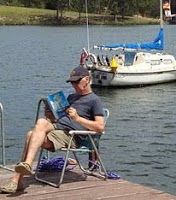|
In memory of Colin (Rover)
18th December 1947 - 31st December 2019
Colin grew up in Sans Souci and his first job was with the Sydney Water board. From there he went on to become involved in many earthmoving and mining projects in Australia and around the globe. Some major projects included the Bougainville copper mine in PNG, the Woodlawn mine and Snowy Scheme in NSW, and he spent time in mines in the Yukon territory of Canada.
His parents bought a property “Jilliby” in the Belowra Valley, some 56km West of Bodalla on the south coast of NSW. When not overseas, Colin would work on the farm and he assisted his parents in establishing it, constructing fences and erecting a weatherboard residence which was a transportable house brought in by truck.
Later on, Colin and his brother Bruce purchased the adjoining properties. Bruce went on to build a modest brick house on Wiley Creek (Woila Creek) for his family and as Colin was often overseas with his work, he never built his own house on his property. Instead, to suit his transient life, Colin bought a house in Hellensburgh which unfortunately he lost to fire while away overseas.
Some years later he then bought a terrace house in Darlinghurst. But Colin maintained a close connection to Belowra and with his insatiable appetite to collect machinery and rusty steel, he stored his acquisitions on the land.
When Colin's parents Harold and Hilda passed away, Colin bought out the land and took over the farm and sheds, which gave him more space to amass even more knick knacks, machinery and the like.
After Colin retired from the mining scene, he retreated to Belowra where he continued to live a simplistic life running the farm and collecting and operating machinery such as dozers and scrapers to name a few. I guess from his experience working in remote regions for so long with basic amenities, he became akin to the basic way of living, and although he had several dwellings on the property, plus his house in Darlinghurst at his disposal, he preferred life in his simple corrugated iron shack at Belowra.
He never had mains electricity and just relied on an old wood stove for his heating and cooking.
Colin had a love of travel and between mining deployments. At one point he spent a short time driving Tour buses from London to Africa through Libia, Tunisia and Algeria.
During his time in Bougainville, in 1972 he became involved with the local branch of the international social running group, the Hash House Harriers. I believe it was here where he was bestowed the name ‘Rover’.
Upon returning to Australia Colin became involved with many of the hash groups in Sydney and was a regular attendee when back in Australia.
Every 2 years, the global hash community hold an international event whereby people from hash groups all over the world come together to run, drink and socialize. Colin regularly did business in Cooma, but in the early days was not aware of the Cooma Hash.
At the 1984 Interhash in Sydney, Colin became aware of presence of a hash group in Cooma when he met several members there. By the late eighties, Colin attended the Cooma hash and their events more and more, forging strong friendships with many.
In 1997, through Colin's generosity, he invited the Cooma hash members and other hash members from the groups that he associated with in Sydney to his property to camp for the weekend. It was held on the last weekend in November and it became an annual pilgrimage for the Cooma hash group who have camped there every year since.
Colin would regard many people from the Cooma Hash and the various Sydney Hashes as his best friends. Cooma being one of the closest populated centres to his property.
In the last 20 years or so he has become very close to many people in Cooma and the surrounding Region. These friends would often visit Colin at his property in Belowra and camp there at various times throughout the year.
Although he never married nor had children of his own, Colin met Threlly, around 14 years ago and they have had a wonderful time together, travelling several times to Threlly’s homeland, the Philippines where he would take supplies and teach the locals his skills.
They also recently enjoyed a camping holiday around Tasmania together planning to travel to South America in the near future.
Colin was an amazing conversationalist who could converse on any topic from engineering, metallurgy and welding to history and global politics.
Someone who despite mainly living alone, loved company and having a yarn. He loved guests and entertaining and cooking his traditional meals such as his roast as he had done since he was young, on the camp fire with an old home made camp oven, with unpeeled root vegetables and drippings from the last roast as the grease.
Someone who was frozen in time (the 50’s) in his fashion sense, his old-time values, respect for others and good mannered. While he was a chef with his Old fashioned cooking techniques there were occasions to apply some Creative cooking techniques as well, like adapting an old aluminium heat sink used to cook cheese filled Kransky on the campfire or a improvising a toaster made by peppering a sheet of corrugated iron with bullets to form the panels for a campfire toaster.
He was a great host who would prepare for weeks in advance, setting up practical jokes, things for entertainment, funny signs etc.He had no time for bullshit, bureaucracy or dishonest people. Reliant on old-school methods, Colin did everything by good verbal communication and writing everything in a pocket book. A true blue Aussie Bushman, a man of the land, a real cow-cocky, Akubra wearing, Drizabone wearing bushie. He was a collector and hoarder (bowerbird) and never threw anything away that had the potential to be reused.
He will be remembered as a very affectionate and caring man, a man who would always remember what was going on in your life and genuinely cared for how you were going. Unbelievably generous in every way he would never turn up empty handed, would almost always bring a gift, from lemons off his lemon tree, home made beef jerky, a gift of food, a cinnamon roll from the bakery, or something that he knocked up in his workshop.
He was selfless, and never wanted to impose on anyone. He would prefer to camp alone in the bush rather than accept a spare bed for the night, it’s just the way he was.
A poet, who could recite many, many hash poems. Fluent in reading, writing and speaking Tok Pisin he learn't in PNG.
Brilliantly mechanically minded, able to fix anything with the most limited resources and tools Colin was a thriftful person who would always repair/alter and reuse things rather than buying them new. He used discarded cooking oil as fuel for his ute and would regularly scour the scrap metal piles at landfills and piles on the side of the road on council collection day to collect useful bits and pieces. An engineering genius, a welding and fabrication master who could do anything from hard facing a bulldozer blade, to fabricating his own trailers from car parts and scrap metal
Many will remember him as a practical joker Colin was also a man frustrated with a world transitioning to electronic technology, although began to embrace it in his later years.
He was a forward planner with a list of projects so long it would take him 200 years to fulfil.
With his passion for mining, fossicking, metal detecting and exploring old mines and ruins his love of camping and exploration and seeing the country never ceased. A great listener, always hungry to learn and full of questions. Never in a hurry, happy to go along at his own pace.
Never phased by dilemmas, hiccups or deviations in plans, Colin was a man always prepared for anything that life threw at him.
He had superb firefighting abilities and was a long time member of his local Belowra Brigade. Constantly advocating for and implementing better fire breaks and fire control measures.
|








































